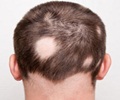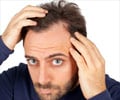- Hair Loss - (https://www.health.harvard.edu/a_to_z/hair-loss-a-to-z)
- Types of Hair Loss - (https://nyulangone.org/conditions/hair-loss/types)
About
Hair loss, medically known as alopecia, can be a distressing experience, impacting one's self-esteem and confidence. It is a common condition that affects millions of people worldwide. While it's normal to shed some hair daily, excessive hair fall can be distressing and may indicate an underlying medical condition(1✔ ✔Trusted Source
Hair Loss
Go to source).
Did You Know?
Hair loss affects millions globally #hairhealth #hairloss #medindiaUnderstanding the various causes of hair loss is essential for timely diagnosis and effective management. From hereditary pattern baldness to medication side effects and psychological disorders, numerous factors can contribute to hair loss.
The Top 10 Medical Reasons Behind Excessive Hair Fall
1. Androgenetic Alopecia (Hereditary Pattern Baldness)
Androgenetic alopecia, commonly referred to as hereditary pattern baldness, is the most prevalent cause of hair loss worldwide. It affects both men and women, although the pattern and progression of hair loss may differ between genders. This condition is characterized by a gradual reduction in hair density and thickness, primarily in genetically predisposed individuals(2✔ ✔Trusted Source
Types of Hair Loss
Go to source).
Men: Typically experience a receding hairline, followed by thinning of hair on the crown (vertex). This often results in a characteristic "M" shape pattern of hair loss.
Women: Tend to experience diffuse thinning of hair over the entire scalp, with preservation of the frontal hairline. Hair thinning may become more noticeable over time.
Diagnosis: It is often based on family history and visual examination. In some cases, additional diagnostic tests, such as scalp biopsies or blood tests to evaluate hormone levels, may be conducted to rule out other potential causes of hair loss.
Treatment: While androgenetic alopecia cannot be cured, various treatment options can help slow down hair loss and promote hair regrowth which includes medications like minoxidil and finasteride, as well as hair transplant surgery.
Prevention: While hereditary pattern baldness cannot be prevented entirely, certain lifestyle measures like maintaining a balanced diet, regular exercise, adequate sleep, and limiting the harsh treatment of hair may help slow down its progression.
2. Telogen Effluvium
Telogen effluvium is a common type of hair loss triggered by significant physical or emotional stress, such as illness, surgery, childbirth, or hormonal changes.
Symptoms: Excessive shedding across the scalp serves as a hallmark symptom of telogen effluvium. This shedding often becomes evident approximately 2-3 months post the stressful event. Patients may notice increased hair fall during routine activities such as showering or brushing their hair.
Diagnosis: It involves evaluating the patient's medical history and identifying the underlying stressor.
Treatment: Hair loss is usually temporary and resolves within 6-12 months without treatment.
Prevention: Managing stress and maintaining a healthy lifestyle can help prevent recurrence.
3. Medication Side Effects
Hair loss as a side effect of medication, known as drug-induced alopecia, can occur with various medications ranging from lithium andbeta-blockers to chemotherapy drugs and hormonal medications.
Symptoms: Medication-induced hair loss often presents as sudden and diffuse shedding of hair from the scalp. Patients may notice an increase in hair fall during routine activities such as washing or brushing their hair. The onset of hair loss may vary depending on the medication and individual factors.
Diagnosis: Diagnosing medication-induced hair loss involves a comprehensive review of the patient's medication list and medical history.
Management: It depends on various factors, including the specific medication involved, the severity of hair loss, and individual patient considerations. In some cases, hair loss may cease once the offending medication is discontinued or replaced with an alternative. However, hair loss may persist or even become permanent in certain individuals.
Precautions: Consulting with a healthcare provider is essential to weigh the risks and benefits of medication adjustments. In some instances, alternative medications with less potential for hair loss may be available. Additionally, healthcare providers may recommend supportive measures to promote scalp health and minimize further hair loss.

4. Autoimmune Conditions (Alopecia Areata)
Alopecia areata is an autoimmune condition characterized by the sudden onset of round bald patches on the scalp or other areas of the body. It occurs when the immune system mistakenly attacks hair follicles.
Symptoms: Alopecia areata typically manifests as the sudden onset of round or oval-shaped bald patches on the scalp. However, it can also affect other areas of the body, such as the eyebrows, eyelashes, or beard. The hair loss occurs rapidly, often leaving smooth, non-scarring bald patches devoid of hair follicles. In some cases, individuals may experience tingling or itching sensations preceding hair loss.
Diagnosis: Diagnosing involves a comprehensive evaluation by a healthcare provider, which may include assessing the scalp, Scalp Biopsy, and Blood Tests.
Treatment: Treatment options for alopecia areata aim to suppress the abnormal immune response and promote hair regrowth. It includes Intralesional Corticosteroid Injections, Topical Immunotherapy, Minoxidil (Rogaine), and other treatment options, such as oral corticosteroids, topical immunomodulators, or phototherapy in severe or refractory cases.
5. Thyroid Disorders
Thyroid disorders, such as hypothyroidism and hyperthyroidism, can disrupt the normal growth cycle of hair follicles, leading to hair loss.
Symptoms:
Hypothyroidism: Symptoms may include fatigue, weight gain, cold intolerance, dry skin, constipation, and changes in mood, such as depression or irritability.
Hyperthyroidism: Symptoms may include weight loss, increased heart rate, heat intolerance, sweating, tremors, anxiety, and changes in bowel habits.
Hair loss in thyroid disorders typically manifests as diffuse thinning of hair, rather than distinct bald patches. Individuals may notice increased shedding during routine activities like washing or brushing their hair.
Diagnosis: Diagnosing thyroid-related hair loss involves Measurement of thyroid hormone levels, Thyroid Imaging, or thyroid antibody levels.
Management: Effective management of thyroid-related hair loss revolves around treating the underlying thyroid disorder.
Medication: Thyroid hormone replacement therapy (e.g., levothyroxine) for hypothyroidism; antithyroid medications, beta-blockers, or radioactive iodine for hyperthyroidism.
Prevention: It involves incorporating lifestyle modifications such as engaging in regular exercise, maintaining balanced nutrition, managing stress effectively, and ensuring adequate sleep. Additionally, regular monitoring through follow-up appointments with healthcare providers is essential to track thyroid function and adjust medication dosages as necessary.
6. Nutritional Deficiencies
Nutritional deficiencies, including inadequate intake or absorption of essential nutrients such as protein, iron, zinc, and biotin, can significantly contribute to hair loss.
Symptoms:
- Brittle Hair: Hair may become dry, brittle, and prone to breakage
- Hair Thinning: Progressive thinning of the hair may occur, leading to decreased hair density and volume
- Excessive Shedding: Individuals may notice increased hair shedding during routine activities like washing or brushing their hair
- Changes in Hair Texture: Hair may appear dull, lackluster, or lacking in vitality.
Diagnosis: Diagnosing hair loss due to nutritional deficiencies typically involves Measurement of serum levels of essential nutrients and Comprehensive Evaluation.
Treatment: Treatment for hair loss due to nutritional deficiencies focuses on correcting the underlying deficiency. It includes dietary changes, supplementation in severe cases.
Prevention: Adopting a balanced and varied diet, maintaining hydration, managing stress, and avoiding excessive alcohol consumption can support overall nutritional status and promote hair health. Patients should consult with their healthcare providers or registered dietitians for personalized guidance and support tailored to their individual needs.
7. Fungal Infections (Tinea Capitis)
Tinea capitis, commonly known as scalp ringworm, is a fungal infection affecting the scalp and hair follicles.
Symptoms:
- Itching: Persistent itching of the scalp is a common early symptom, often accompanied by discomfort and irritation
- Scaling: Scalp scaling, characterized by the presence of flaky or crusty patches, may occur, particularly in affected areas
- Patchy Hair Loss: Circular or irregular patches of hair loss may develop on the scalp, often accompanied by broken or brittle hairs at the surface
- Scalp Inflammation: The affected scalp areas may appear red, swollen, or inflamed, indicating the presence of an active infection.
Diagnosis: Diagnosing tinea capitis involves microscopic examination of hair, Fungal Cultures, examination of the scalp and affected areas.
Treatment: Treatment for tinea capitis typically involves antifungal medications to eliminate the fungal infection, Medicated Shampoos containing active ingredients such as ketoconazole or selenium sulfide, and in some cases topical antifungal creams or ointments.
Prevention: Maintaining good scalp hygiene and avoiding sharing personal items such as combs or hats can help minimize the risk of spreading the infection to others.
8. Systemic Illnesses
Certain systemic illnesses, such as lupus and syphilis, can cause hair loss as a secondary symptom.
Symptoms:
Hair loss associated with systemic illnesses may coincide with other characteristic symptoms of the underlying condition.
- Rash: Some systemic illnesses, such as lupus, may present with skin rashes that can affect the scalp and contribute to hair loss
- Joint Pain: Conditions like lupus or rheumatoid arthritis may cause joint pain or inflammation, which can indirectly impact hair health
- Fever: Systemic infections or inflammatory conditions may lead to fever, which can be accompanied by hair shedding
- Other Systemic Symptoms: Depending on the specific underlying illness, individuals may experience a range of systemic symptoms such as fatigue, malaise, weight changes, and organ-specific manifestations.
Diagnosis: Diagnosing hair loss secondary to systemic illnesses involves comprehensive review of the medical history, a thorough physical examination, and additional tests, such as blood tests, imaging studies, or biopsies.
Treatment: Treatment for hair loss secondary to systemic illnesses focuses on managing the underlying condition.
9. Traumatic Alopecia
Traumatic alopecia refers to hair loss caused by physical trauma to the hair follicles, such as excessive pulling, heat styling, or chemical damage.
Symptoms:
- Hair Breakage: Hair strands may become weak, brittle, and prone to breakage, particularly in areas subjected to repeated trauma
- Thinning: Gradual thinning of the hair may occur, particularly along the hairline or in areas where tension or pressure is applied
- Bald Spots: Severe or chronic trauma to the hair follicles may lead to the development of bald spots or areas of complete hair loss
- Scalp Sensitivity: Individuals may experience scalp tenderness, irritation, or discomfort in regions affected by traumatic alopecia.
Diagnosis: Diagnosing traumatic alopecia involves detailed history to identify potential sources of physical trauma to the hair follicles, a thorough examination of the scalp and hair and in some cases, dermatoscopic examination or scalp biopsy.
Treatment and Prognosis: The prognosis for traumatic alopecia depends on the extent of hair follicle damage and the adoption of preventive measures. In mild cases, hair regrowth may occur once the source of trauma is removed. However, severe or chronic traumatic alopecia may result in permanent hair loss, necessitating alternative treatment options such as hair transplantation or scalp micropigmentation.
Prevention: Preventing traumatic alopecia involves adopting gentle hair care practices and minimizing activities that can cause damage to the hair follicles like avoiding tight hairstyles, limiting heat styling, applying heat protectant products and choosing gentle hair care products.
10. Psychological Disorders (Trichotillomania)
Trichotillomania is a psychological disorder marked by the compulsive urge to pull out one's hair, leading to hair loss and bald patches.
Symptoms:
It presents with distinctive symptoms related to hair pulling behavior.
- Compulsive Hair Pulling: Individuals experience recurrent and uncontrollable urges to pull out their hair, often from the scalp, eyebrows, eyelashes, or other body areas.
- Feelings of Tension: Before engaging in hair pulling, individuals may experience increasing tension or anxiety. Pulling out hair provides a temporary sense of relief or gratification.
- Bald Patches: Continued hair pulling over time results in noticeable hair loss, thinning, or bald patches in affected areas.
- Emotional Distress: Individuals may feel ashamed, embarrassed, or distressed about their hair pulling behavior, leading to social withdrawal or avoidance of certain activities.
Diagnosis: Diagnosing trichotillomania involves a comprehensive evaluation by a healthcare provider or mental health professional.
Treatment: It involves Cognitive-Behavioral Therapy (CBT); medications such as selective serotonin reuptake inhibitors (SSRIs), n-acetylcysteine (NAC), or other psychiatric medications; participation in support groups or therapy groups or alternative therapies such as relaxation techniques, mindfulness meditation, acupuncture or yoga.
In summary, experiencing hair loss can be a challenging and distressing journey for many individuals. However, by understanding the diverse medical reasons behind excessive hair fall and taking proactive steps towards diagnosis and treatment, individuals can regain control over their hair health. Remember, each individual's journey with hair loss is unique, but with the right knowledge and resources, it's possible to navigate this challenge with confidence and resilience.












